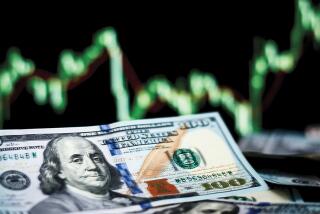Wal-Mart to Buy Big British Grocery Firm
- Share via
Wal-Mart Stores Inc. announced Monday it will buy Britain’s third-largest supermarket chain in an aggressive bid to expand the company’s European foray beyond its German toehold.
The world’s largest retailer, Wal-Mart said it will pay $3.54 cash for each share of the Asda Group, for a deal worth about $10.8 billion. Wal-Mart’s offer undercut merger talks with Asda’s British rival Kingfisher, which would have created Britain’s largest retailer.
While Wal-Mart’s moves into Europe have been slow, analysts say they are well thought out, with Asda a prime example.
Asda, a so-called hypercenter, boasts a merchandise mix that is similar to Wal-Mart’s super-center format, with both food and apparel. But perhaps more importantly, Asda has already introduced a value-pricing format, albeit a limited one, which Wal-Mart probably will expand beyond anything British shoppers have seen.
Analysts expect British consumers to embrace Wal-Mart, but the giant may cause headaches for British retailers that are unaccustomed to aggressive price competition. One analyst said competitors’ prices are likely to drop 5%.
“British retailers are worried, and they should be worried,” said Asma Usmani, a retail analyst with St. Louis investment firm Edward Jones. “It will change the way British consumers view the retailers. I don’t know if the consumer has become as value-conscious because they haven’t really had the opportunity. Now they will.”
With holdings mostly in North and South America, Wal-Mart’s international division has 726 stores, including four in South Korea and six in China.
So far, the European holdings have been in Germany alone. Wal-Mart bought a chain of 21 German superstores in 1997 and then added a 74-store chain in Germany at the end of last year. All those stores will be brought under the Wal-Mart name by the end of this year, although a spokesman said it was too early to say whether Asda stores will be likewise renamed.
The Bentonville, Ark.-based company has said that in the next three to five years, the international division will account for about 30% of earnings growth.
For the fiscal year ending Jan. 31, 1999, Wal-Mart’s international division generated $12.25 billion in sales, a fraction of the company’s total sales of $137.6 billion. The division reported a profit of $551 million.
Some critics have suggested that the Wal-Mart formula is not easily transferred overseas--especially in Europe, where there are deeply ingrained and very different shopping patterns. With more limited storage space, often smaller refrigerators and a premium on fresh foods, most Europeans shop more frequently than Americans. What’s more, many local governments strictly control the hours retail establishments can operate, forcing closure during the evening and weekend hours that have made fortunes for many U.S. retailers.
But other analysts suggest that Wal-Mart has already learned a great deal in Germany. They will also have Asda, and its customer base, as tutors.
What’s more, the predicted backlash against Wal-Mart’s very American sensibilities and its threat to local retailers never materialized in any serious way--at least as far as consumers are concerned. According to Bernard Sosnick, a retail analyst with JW Genesis Capital Markets in New York, fears of American cultural imperialism were drowned out by emergent European bargain hunters.
“What we find is that consumers respond to low prices, to excellent assortment, to friendly greetings, and that is universal,” said Sosnick.
Separately, Wal-Mart said Monday that Bob L. Martin, 50, the president and chief executive of the international division, is leaving to pursue other business interests. His duties will be assumed by John Menzer, the company’s executive vice president and chief financial officer.
More to Read
Inside the business of entertainment
The Wide Shot brings you news, analysis and insights on everything from streaming wars to production — and what it all means for the future.
You may occasionally receive promotional content from the Los Angeles Times.









